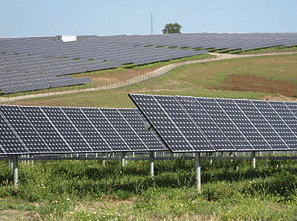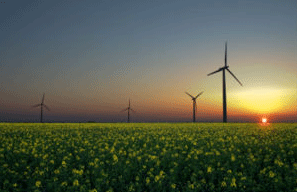Concentrating
Solar Power Plant in Spain and Powerful Solar Power
Plant in Portugal Combat Climate Change |
 Serpa Solar Power Plant
Phorto: Wikipedia.
Serpa Solar Power Plant
Phorto: Wikipedia. |
| The first commercial
scale concentrating solar power (CSP) plant
in Europe was inaugurated in the Southern
Spanish city of Seville in March 2007. The
11 MW plant has been designed to produce
23 GWh of electricity a year, enough to
supply a population of 10,000. This production
of solar electricity avoids the emission
of about 16,000 tonnes of CO2 each year.
|
| |
The
CPS project called PS10 produces electricity
via 624 movable mirrors (heliostats) of
120 m2 surface each that concentrates
solar radiation to the top of a 115-m-
high tower where the solar receiver and
the steam turbine are located. |
|
|
The
PS10 solar plant is situated 25 km west of the city
of Seville and is promoted by the company Abengoa. The
investment costs amounted to ?35 million, with a contribution
of ?5 million from the European Union's Fifth Framework
Programme for research awarded for its highly innovative
approach. |
The
project execution took 54 months, from 1 July 2001 to
31 December 2005. |
PS10
is the first of a set of solar electric power generation
plants to be constructed in the same area which will
produce a total of more than 300 MW by 2013. |
|
The
solar farm of Serpa in southern Portugal, inaugurated
in March 2007, has a capacity of 11 MW and is expected
to produce, with its 52,000 photovoltaic modules, 20
gigawatt/hours of power per year, enough to supply 8,000
homes. The Solar farm, which covers about 60 hectares
of pastures for sheep, saves 30,000 tonnes of CO2 emissions
per year, according to its promoters. |
According
to the European Commission press report of October 2,
2007, it is considered to be the world's most powerful
solar power plant. |
"This plant is a good example of the benefits that
renewable sources of energy can bring: it creates jobs,
it reduces greenhouse gas emissions and it reduces our
foreign energy dependency", said Commissioner Piebalgs
after visiting the plant on October 2,2007. |
European
Commission’s Binding Target for Renewable Sources
of Energy |
In
December 2007, the European Commission
will table a framework directive with
measures to reach the binding target
for Renewable Sources of Energy as agreed
by the European Council last March:
20% of Energy Consumption. |
| |
For
first time, the directive will take
into consideration heating and cooling
from renewable sources of energy, together
with the two traditional sectors, sustainable
biofuels and green electricity. |
|

Alternative Energies Photo:Wikipedia |
|
Photovoltaic
is one of the technologies that could be used for the
production of green electricity. |
"These
new technologies give Europe a new option to combat
climate change and increase energy security while strengthening
the competitiveness of the European industrial sector
and creating jobs and growth", said Energy Commissioner
Andris Piebalgs, on the occasion of the inauguration
of the plant. |
Facts on Concentrating Solar
Power
|
PS10
is an example of so-called Concentrating Solar Power
plants which use solar radiation as a high-temperature
energy source to produce electricity via concentrating
heliostats in a thermodynamic cycle. The need for Concentrating
Solar Power technology arises because solar radiation
reaches the Earth's surface with a density that is adequate
for heating systems but not for an efficient thermodynamic
cycle for electricity production. |
The potential contribution of Concentrating Solar Power
plants to a more sustainable energy system has still
to be fully exploited. The EU has been supporting the
Concentrating Solar Power (CPS) sector for more than
ten years facilitating efforts to research, develop,
validate, demonstrate and disseminate the performance
of these technologies in both the public and private
sector. |
Under
the Fifth and Sixth Framework Programmes for Research,
the EU has contributed with some ?25 million to research
projects working to develop CSP technologies. |
This contribution has had a multiplying effect by leveraging
a large amount of additional private investment worth
several hundred million Euro, in a ratio of about ?10
for each Euro invested by the European research programme. |
Research,
technological development and demonstration of a new
generation of renewable energy technologies has an essential
role to play in meeting growing energy demand and allowing
Concentrating Solar Power technologies to become another
EU success story. |
| For more information:
http://ec.europa.eu/energy/res/sectors/csp_diss_en.htm |
| Global Wind Energy
Markets Exceed 2006 Expectations |
Industry
delivered 32% of annual market growth: The booming wind
energy markets around the world exceeded expectations
in 2006, with the sector experiencing yet another record
year. These figures, which include wind energy developments
in more than 70 countries around the world, show that
the year saw the installation of 15,197 megawatts (MW),
taking the total installed wind energy capacity to 74,223
MW, up from 59,091 MW in 2005. |
On
the day of the publication of the 4th Assessment Report
on Climate Change by the IPCC, the Global
Wind Energy Council (GWEC) released its annual figures
for 2006. These figures, which include wind energy developments
in more than 70 countries around the world, show that
the year saw the installation of 15,197 megawatts (MW),
taking the total installed wind energy capacity to 74,223
MW, up from 59,091 MW in 2005. |
Despite
constraints facing supply chains for wind turbines,
the annual market for wind continued to increase at
the staggering rate of 32% following the 2005 record
year, in which the market grew by 41%. This development
shows that the global wind energy industry is responding
fast to the challenge of manufacturing at the required
level, and manages to deliver sustained growth. |
In
terms of economic value, the wind energy sector has
now become firmly installed as one of the important
players in the energy markets, with the total value
of new generating equipment installed in 2006 reaching
?18 billion, or US$23 billion. |
The
countries with the highest total installed capacity
are Germany (20,621 MW), Spain (11,615 MW), the USA
(11,603 MW), India (6,270 MW) and Denmark (3,136). Thirteen
countries around the world can now be counted among
those with over 1000 MW of wind capacity, with France
and Canada reaching this threshold in 2006. |
In
terms of new installed capacity in 2006, the US continued
to lead with 2,454 MW, followed by Germany (2,233 MW),
India (1,840 MW), Spain (1,587 MW), China (1,347 MW)
and France (810 MW). |
This
development shows that new players such as France and
China are gaining ground. ?The tremendous growth in
2006 shows that decision makers are starting to take
seriously the benefits that wind energy development
can bring. However, we must not forget that wind energy
is a new technology that needs robust policy frameworks
and political commitment to fulfill its full potential,?
said Arthouros Zervos, Chairman of GWEC. |
Europe |
Europe
is still leading the market with 48,545 MW of installed
capacity at the end of 2006, representing 65% of the
global total. In 2006, the European wind capacity grew
by 19%, producing approximately 100 TWh of electricity,
equal to 3.3% of total EU electricity consumption in
an average wind year. |
While
Germany and Spain still represent 50% of the EU market,
we are seeing a healthy trend towards less reliance
on these two countries. In the EU, 3,755 MW were installed
outside of Germany, Spain and Denmark in 2006. In 2002,
this figure still stood at only 680 MW, said Christian
Kjaer, the European Wind Energy Association?s (EWEA)
CEO. The figures clearly confirm that a second wave
of European countries is investing in wind power. |
Despite
the continuing growth in Europe, the general trend shows
that the sector is gradually becoming less reliant on
a few key markets, and other regions are starting to
catch up with Europe. The growth in the European market
in 2006 accounted for about half of the total new capacity,
down from nearly three quarters in 2004. |
Asia |
Asia
has experienced the strongest increase in installed
capacity outside of Europe, with an addition of 3,679
MW, taking the continent over 10,600 MW. In 2006, the
continent grew by 53% and accounted for 24% of new installations.
The strongest market here remains India with over 1,840
MW of new installed capacity, which takes its total
figure up to 6,270 MW. |
China
more than doubled its total installed capacity by installing
1,347 MW of wind energy in 2006, a 70% increase from
last year?s figure. This brings China up to 2,604 MW
of capacity, making it the sixth largest market world
wide. The Chinese market was boosted by the country's
new Renewable Energy Law, which entered into force on
1 January 2006. |
"Thanks
to the Renewable Energy law, the Chinese market has
grown substantially in 2006, and this growth is expected
to continue and speed up. According to the list of approved
projects and those under construction, more than 1,500
MW will be installed in 2007. The goal for wind power
in China by the end of 2010 is 5,000 MW, which according
to our estimations will already be reached well ahead
of time,? said Li Junfeng of the Chinese Renewable Energy
Industry Association (CREIA).
|
North
America |
22%
of the world?s new wind capacity was installed in North
America, where the annual market increased by a third
in 2005, gaining momentum in both the US and Canada.
|
For
the second year running, the US wind energy industry
installed nearly 2,500 MW, making it the country with
the most new wind power. |
'Strong
growth figures in the US prove that wind is now a mainstream
option for new power generation,' said Randy Swisher,
President of the American Wind Energy Association (AWEA).
|
'Wind's
exponential growth reflects the nation's increasing
demand for clean, safe and domestic energy, and continues
to attract both private and public sources of capital.
New generating capacity worth US$4 billion was installed
in 2006, billing wind as one of the largest sources
of new power generation in the country' second only
to natural gas' for the second year in a row.' |
Canada
also had a record year, with the installed capacity
more than doubling from 683 MW in 2005 to 1459 MW at
the end of 2006. 'Wind energy is an emerging Canadian
success story and 2006 will be remembered as the year
that our country first began to seriously capture its
economic and environmental benefits,' said Robert Hornung,
President of the Canadian Wind Energy Association (CanWEA).
'Canada's is on the cusp of a wind energy boom as provincial
governments are now targeting to have a minimum of 10,000
MW of installed wind energy capacity in place by 2015.' |
Africa
and Middle East |
Growth
in the relatively young African and Middle Eastern market
picked up considerably in 2006, with 172 MW of new installed
capacity, bringing the total up to 441 MW. This represents
a 63% growth, and should be seen as a promising signs
for future developments. The main countries experiencing
growth are Egypt (230 MW, up from 145 MW), Morocco (124
MW, up from 64 MW) and Iran (48 MW, up from 23 MW). |
Compared
to previous years, the Australian market only experienced
slow growth in 2006. "While 2006 saw only 109 MW
installed bring total capacity to 817 MW, the Australian
market has been given a new lease of life with the introduction
of state based renewable energy targets providing a
more positive outlook for 2007," said Dominique
La Fontaine, CEO of the Australian Wind Energy Association
(Auswind). |
'As
security of energy supply and climate change are ranging
high on the political agendas of the world's governments,
wind energy has already become a mainstream energy source
in many countries around the world. Wind energy is clean
and fuel free,which makes it the most attractive solution
to the world's energy challenges,' said Arthouros Zervos,
Chairman of GWEC. |
Global
Wind Energy Council (GWEC), http://www.gwec.net,
is the global forum for the wind energy sector, uniting
the wind industry and its representative associations. |
The
member associations of GWEC operate in more than fifty
countries and represent: |
-
Over 1,500 companies, organisations
and institutions
-
All the world?s major wind turbine
manufacturers
-
99% of the world?s more than
73,000 MW of installed wind power capacity
|
The
following organisations are Members of the GWEC Board: |
-
Acciona Energ'a
-
Airtricity
-
Associazione Nazionale Energia
del Vento (ANEV)
-
Australian Wind Energy Association
(AusWind)
-
American Wind Energy Association
(AWEA)
-
Bundesverband Windenergie (BWE)
-
Canadian Wind Energy Association
(CanWEA)
-
Chinese Renewable Energy Industries
Association (CREIA)
-
European Wind Energy Association
(EWEA)
-
Gamesa
-
Garrad Hassan
-
GE Wind Energy
-
Hansen Transmissions
-
Iberdrola
-
Indian Wind Turbine Manufacturers
Association (IWTMA)
-
Japanese Wind Energy Association
(JWEA)
-
LM Glasfiber
-
Nordex AG
-
Renewable Energy Systems (RES)
-
Shell WindEnergy
-
Siemens Wind
-
Suzlon Energy
-
Vestas Wind Systems
|
Projects |
NREL's
R&D projects in concentrating solar power focus
on parabolic trough solar technology and advanced concentrating
solar power technologies. We also support the U.S. Department
of Energy in its concentrating solar power deployment
efforts. |
Parabolic Trough Solar Technology
|
Parabolic
trough solar technology is a proven, robust, and reliable
power source for large, utility-scale power plants.
In addition to proven performance, the main advantages
of parabolic troughs include: |
-
Manufacturing simplicity
-
Use of standard equipment and
improvements
-
Improvement in cost effectiveness
-
Low technical and financial
risk to the investor.
|
Despite
its advantages, parabolic trough solar technology is
not yet cost competitive in today's energy market. However,
the technology has great potential for cost reduction.
NREL works not only to improve parabolic trough technology
but also to increase its cost effectiveness through
the following R&D projects: |
|
Advanced Concentrating Solar
Power Technologies
|
NREL's
research and development in advanced concentrating solar
power technologies includes the following crosscutting
projects that aren't tied to a single concentrating
solar power technology: |
|
Concentrating Solar Power System
Deployment
|
NREL
currently supports the following U.S. Department of
Energy concentrating solar power system deployment efforts: |
|
How Much It Will
Cost to Power An House With Solar Energy?
|
| SOLAR PANEL SYSTEMS:
THE INITIAL INVESTMENT |
| Solar panel systems initial
cost is higher than classic gas or electric systems. Most
homeowners and homebuilders choose conventional systems
for that treason. |
But
that doesn’t mean that today’s solar power
systems aren’t cost competitive.
The option may be environmental, but also economical. |
As
natural gas, fuel and electricity becomes more and more
costly, solar become more and more advantageous. |
A
recent study undertaken by Florida Solar Energy Center
(FSEC),
a research institute of the University of Central Florida,
found that solar water heaters offered great savings.
Annual costs are 50% to 85% lower for solar water heather
than those for electric water heaters. |
In
today's USA market the average price of an active solar
hot water system is around $2,500-$4,000 per home (or
half of that for systems without circulating pumps and
controls). |
|
SOLAR SYSTEMS: PAYBACK PERIODS
|
You
can recover your initial investment on solar power systems
in a short period, or in a much longer one... It depends
on the type of solar power system. |
|
|
The
payback period for PV
solar electricity is larger: 8 - 10 years or more.
It all depends on eventual rebates, tax credits, home
insulation or on the scale of production... |
Remember:
the payback period may vary, but after it the energy
costs are nearly zero... |
| Costs and Payback of
Solar Space Heating |
In
the case of solar space heating, costs may vary widely.
The simplest solutions (solar wall heaters) are relatively
inexpensive, say, $700 - $1000 per collector/room. But
they have a restricted set of uses; they can be a good
solution for heating a room or as an auxiliary heating
device, and just that. |
Other
active solar space-heating systems demand a much higher
initial investment. They are more sophisticated in design
and maintenance than solar water-heating systems, and
demand a higher investment in collectors and hardware.
With today’s technology they aren’t as cost-effective
as the solar water-heating systems and they have a longer
payback: two or three years more at least. |
Climate
is another major element in cost-evaluation of solar
space systems. These systems are obviously more cost-effective
in climates with extended heating seasons and many sunny
days. If you live in a state as Florida, with short
heating seasons, the system becomes less interesting
and less competitive… |
| See also: |
|
| |

